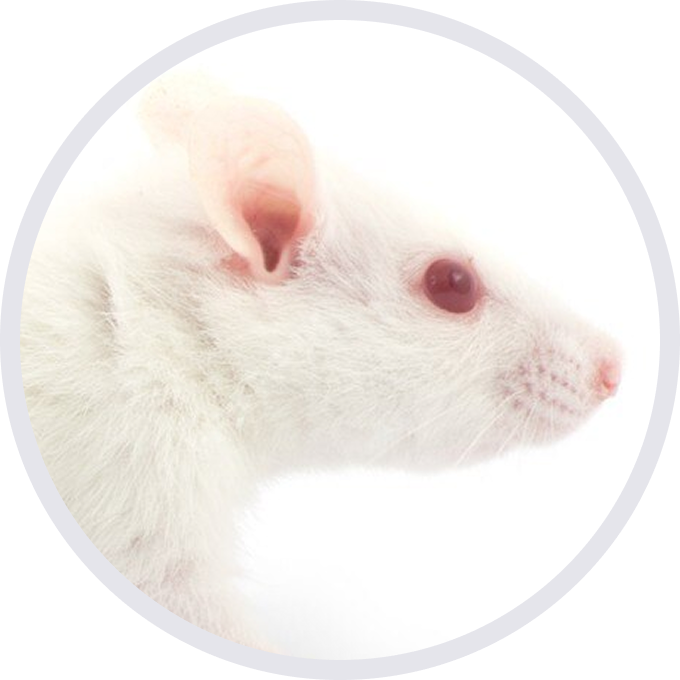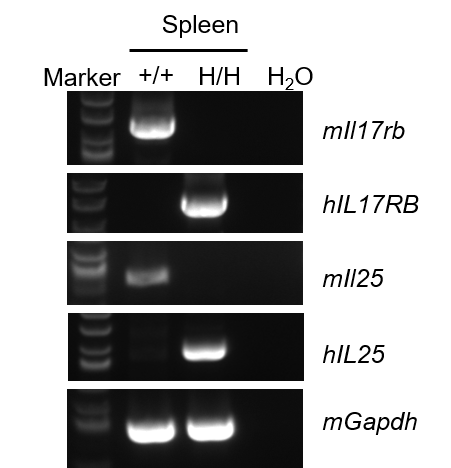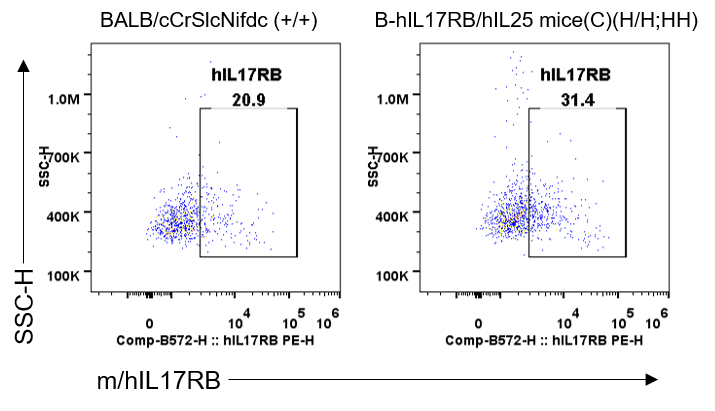
BALB/cCrSlcNifdc-Il17rbtm1(IL17RB)BcgenIl25tm1(IL25)Bcgen/Bcgen • 113301

| Product name | B-hIL17RB/hIL25 mice(C) |
|---|---|
| Catalog number | 113301 |
| Strain name | BALB/cCrSlcNifdc-Il17rbtm1(IL17RB)BcgenIl25tm1(IL25)Bcgen/Bcgen |
| Strain background | BALB/cCrSlcNifdc |
| NCBI gene ID | 55540,64806 (Human) |
| Aliases | CRL4; EVI27; IL17BR; IL17RH1; IL17E; IL17RH1; IL17E |
Gene targeting strategy for B-hIL17RB/hIL25 mice(C).
The exons 2-3 of mouse Il25 gene that encode the whole molecule, including 3’UTR were replaced by human counterparts in B-hIL17RB/hIL25 mice(C). The promoter and 5’UTR region of the mouse gene are retained. The human IL25 expression is driven by endogenous mouse Il25 promoter, while mouse Il25 gene transcription and translation will be disrupted.
The exons 2-10 of mouse Il17rb gene that encode extracellular domain are replaced by human counterparts in B-hIL17RB/hIL25 mice(C). The genomic region of mouse Il17rb gene that encodes signal peptide, transmembrane domain and cytoplasmic portion is retained. The promoter, 5’UTR and 3’UTR region of the mouse gene are also retained. The IL17RB expression is driven by endogenous mouse Il17rb promoter, while mouse Il17rb gene transcription and translation will be disrupted.

Strain specific analysis of IL25 and IL17RB mRNA expression in wild-type BALB/cCrSlcNifdc mice and homozygous B-hIL17RB/hIL25 mice(C) by RT-PCR. Spleen RNA was isolated from wild-type BALB/cCrSlcNifdc mice (+/+) and homozygous B-hIL17RB/hIL25 mice(C) (H/H;H/H), then cDNA libraries were synthesized by reverse transcription, followed by PCR with mouse or human IL25 and IL17RB primers. Mouse Il25 and Il17rb mRNA was only detectable in wild-type mice. Human IL25 and IL17RB mRNA was exclusively detectable in homozygous B-hIL17RB/hIL25 mice(C) but not in wild-type mice.

Strain specific IL17RB expression analysis in homozygous B-hIL17RB/hIL25 mice(C) by flow cytometry. Splenocytes were collected from wild-type BALB/cCrSlcNifdc mice (+/+) and homozygous B-hIL17RB/hIL25 mice(C) (H/H;H/H), and analyzed by flow cytometry with anti- IL17RB antibody (R&D, FAB1207P-025). Mouse IL17RB was detectable in macrophages of wild-type mice. Human IL17RB was detectable in macrophages of homozygous B-hIL17RB/hIL25 mice(C).